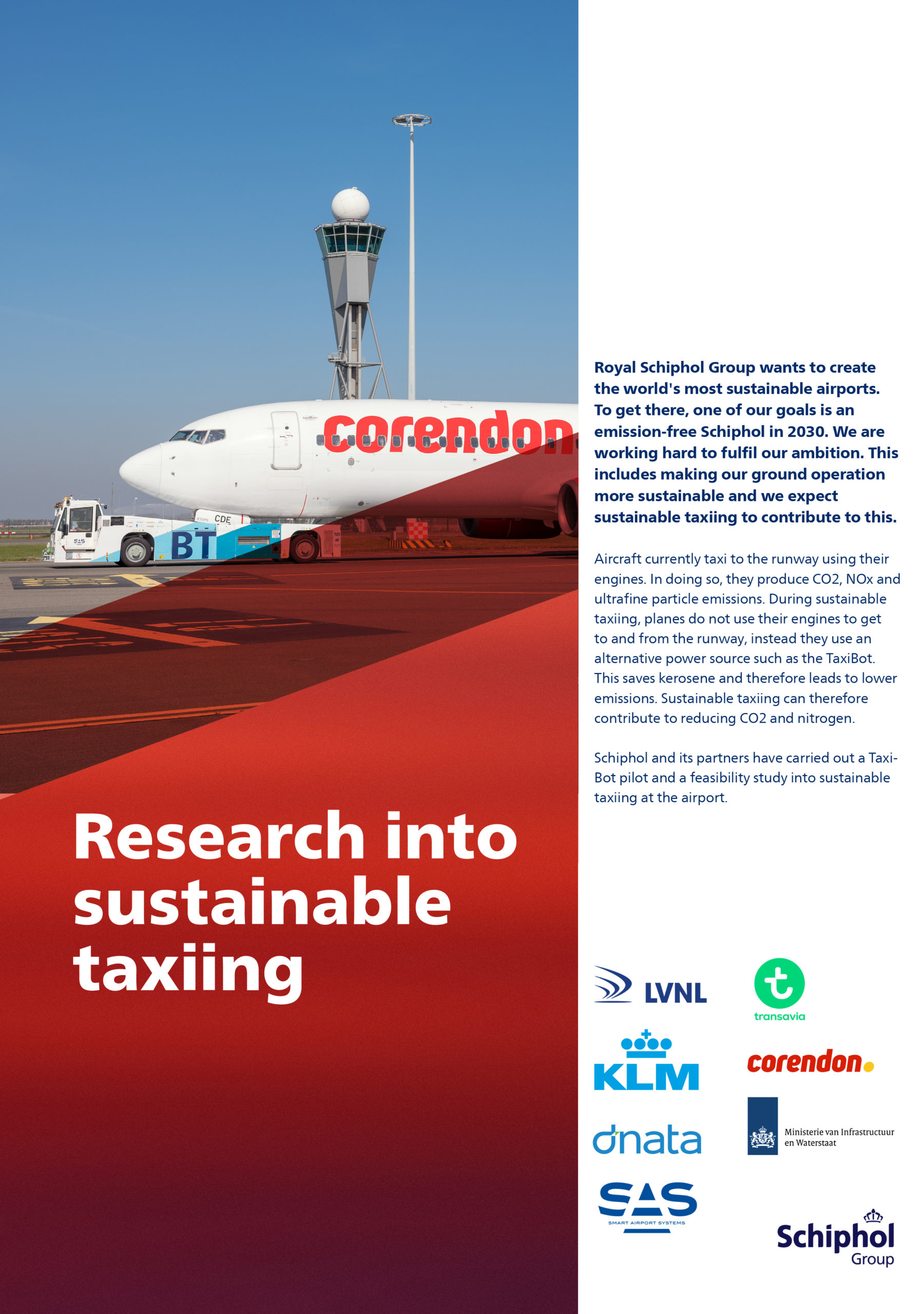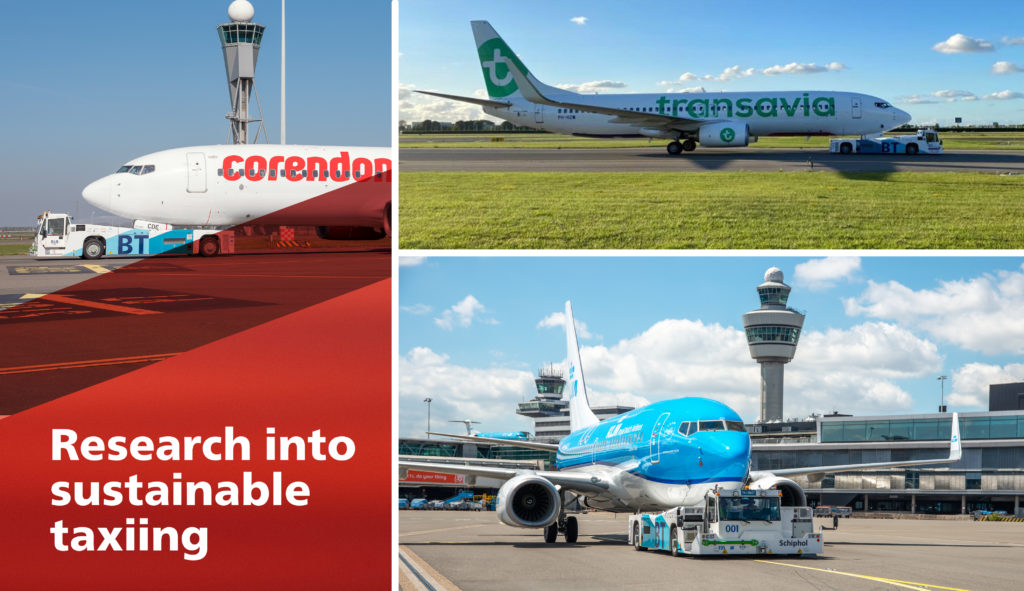News
 Schiphol Feasibility Study Confirms ‘TaxiBot’ as Integral to Sustainable Taxiing Program
Schiphol Feasibility Study Confirms ‘TaxiBot’ as Integral to Sustainable Taxiing Program

PRESS RELEASE FROM ROYAL SCHIPHOL GROUP
Royal Schiphol Group wants to create the world’s most sustainable airports. To get there, one of our goals is an emission-free Schiphol in 2030. We are working hard to fulfil our ambition. This includes making our ground operation more sustainable and we expect sustainable taxiing to contribute to this.
Aircraft currently taxi to the runway using their engines. In doing so, they produce CO2, NOx and ultrafine particle emissions. During sustainable taxiing, planes do not use their engines to get
to and from the runway, instead they use an alternative power source such as the TaxiBot. This saves kerosene and therefore leads to lower emissions. Sustainable taxiing can therefore contribute to reducing CO2 and nitrogen.
Schiphol and its partners have carried out a Taxi- Bot pilot and a feasibility study into sustainable taxiing at the airport.
What did we investigate?
We looked at whether implementing fully sustai- nable taxiing at Schiphol airport would be possible. The primary focus was on the effects of sustainable taxiing on safety, capacity, efficiency at the airport and the environmental benefits. The study compri- sed an operational pilot carried out at Schiphol last year, a simulation of an airport operation based on sustainable taxiing and consultations with operatio- nal experts.
Who did we conduct the research with?
Schiphol collaborated with Air Traffic Control the Netherlands (LVNL), KLM, Transavia, Coren- don Dutch Airlines and ground handling compa- nies dnata and KLM Ground Services. The rese- arch is part of the Smart and Sustainable action plan and the government’s plan for sustainable aviation (Klimaattafel Duurzame Luchtvaart).
What were the most significant findings?
The results revealed that sustainable taxiing uses at least 50% less fuel than standard taxiing and therefore significantly lowers emissions, both CO2 and noise emissions. Some substantial adjustments to infrastructure, processes and technology will need to be made if sustainable taxiing is to become standard procedure at Schiphol by 2030.
What are the adjustments that need to be made to infrastructure?
In order to implement sustainable taxiing as standard procedure at Schiphol by 2030, a num- ber of changes will need to be made, including to infrastructure. This will involve modifying the platform and taxiways so that a unique semi-ro- botic aircraft towing vehicle can be decoupled from the aircraft safely and efficiently. The taxiways will also have to be adjusted so that the TaxiBot can move everywhere, and so will the aircraft stand so that the TaxiBot can safely park the plane at the gate.
What are the adjustments that need to be made to processes?
Many different airport partners are involved
in sustainable taxiing. The handling agent is responsible for operating the TaxiBot before it has been attached to an airplane, the pilot is responsible for operating the TaxiBot while it is attached to the airplane and LVNL is responsible for the successful management of ground traffic.
The roles of the parties involved are constantly changing, which makes the implementation
of sustainable taxiing as standard procedure
a complex process. It also means more traffic movements because a TaxiBot has to drive to and from the runways. New working arrange- ments, protocols and guidelines are required to manage this effectively.
We will also have to ensure that ground hand- ling company staff are trained to operate the TaxiBot, and pilots will have to receive extra computer training (even those working for foreign airlines who do not often come to Schiphol).
What are the adjustments that need to be made to technology?
The TaxiBot is a unique Smart Airport Systems vehicle; there are only a small number of them in the world. This means that the TaxiBot also still needs to be developed further.
The TaxiBot is certified for the most common narrow-body types of aircraft (Boeing 737 and Airbus A320), which together account for 54 percent of air traffic to and from Schiphol. It is not yet ready and certified for other types of aircraft. A widebody version is due in 2023.
Although the TaxiBot is today not fully emission free as it is powered by diesel-electric driveline, it does represent a substantial reduction of the carbon footprint of airport operations on its own. Smart Airport Systems is currently designing a full electrical unit, including technical improvements to make the TaxiBot more reliable.
Why can sustainable taxiing only be implemented on a large scale in 2030?
Almost all aircraft will need to be towed when sustainable taxiing is a standard procedure. Sig- nificant adjustments to infrastructure, processes and technology are therefore required (and at a complex location). The aviation sector has high safety standards; the certification of technolo- gies and approval of processes are extremely important and carried out carefully.
Because many of the necessary adjustments are new to aviation, and because Schiphol is the first airport in Europe that wants to introduce sus- tainable taxiing on a large scale, a lot of time is required to develop the technology and to have it certified and approved.
On a smaller scale, sustainable taxiing can contribute to the reduction of emissions at the locations it will have the biggest impact within just a few years. This could be at the Polderbaan Runway, for example. It has the longest taxi time and, together with the Kaagbaan Runway, is deployed most frequently.
What are other airports doing?
There are currently only a small number of TaxiBots in the world. The TaxiBot has grabbed the attention of many large airports and it appears to be a question of time before it is tested and implemented at other airports too.
Some TaxiBots are being deployed in the operation in India since a few years – in Delhi and in Bangalore. We are keenly following those developments, especially those in Delhi seeing as the airport is comparable to Schiphol in terms of size, activity and complexity.
What are the next steps?
We and the airport partners are going to iden- tify the necessary adjustments and solutions in a roadmap to establish sustainable taxiing as standard procedure at Schiphol by 2030. This roadmap will be ready in the spring of 2021.
We will also start a follow-up pilot – part of a Eu- ropean programme that will see several Taxibots coming to Schiphol – no later than at the start of 2022. The preparations for that are underway.